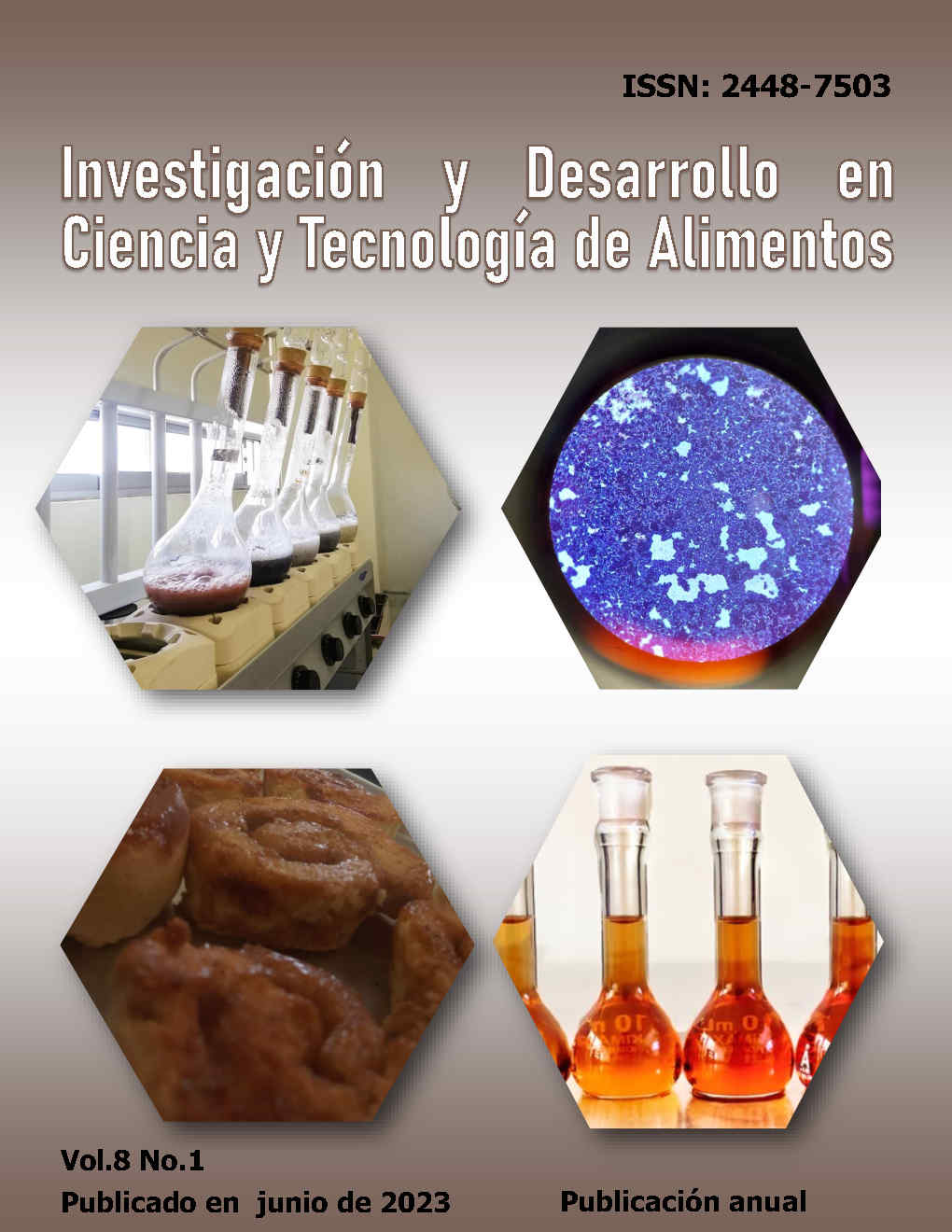Estudio de los atributos fisicoquímicos de calidad que influyen en la vida útil de muffins de vainilla
DOI:
https://doi.org/10.29105/idcyta.v8i1.113Keywords:
Bread stealing, shelf life, muffin, kinetic modelingAbstract
A muffin is a small round cake elaborated without sugar. In general, baked products have been the subject of various investigations due to the interaction between their components and their deterioration. Since vainilla muffins used in this investigation had good microbiological stability due to preservative agents incorporated in their formulation, the objective of this work was to determine which quality physicochemical parameters have the greatest influence on their shelf life, using the accelerated testing approach, in order to propose strategies to prolong it. For this, the muffins were stored at different temperatures. Changes in moisture content, water activity and weight were determined in triplicate. The results were adjusted with different mathematical models. Muffin weight loss was the variable with the greatest influence on product shelf life and was adjusted to the equation of order zero (=0.817±0.308). In conclusion, the kinetic analysis provides a reliable criterion to predict the stability and shelf life of muffins, with the information obtained here it is possible to establish strategies to increase shelf life.
Downloads
References
Al-Mahsaneh, M., Aljarrah, M., Rababah, T., & Alu’datt, M. (2018). Using MR-FTIR and texture profile to track the effect of storage time and temperature on pita bread staling. Journal of food quality, 2018. DOI: https://doi.org/10.1155/2018/8252570
Arp, C. G., Correa, M. J., & Ferrero, C. (2020). Kinetic study of staling in breads with high-amylose resistant starch. Food Hydrocolloids, 106, 105879 DOI: https://doi.org/10.1016/j.foodhyd.2020.105879
Baik, M. Y., & Chinachoti, P. (2000). Moisture redistribution and phase transitions during bread staling. Cereal Chemistry, 77(4), 484–488 DOI: https://doi.org/10.1094/CCHEM.2000.77.4.484
Bhaduri, S. (2013). A comprehensive study on physical properties of two gluten-free flour fortified muffins. Journal of Food Processing and Technology, 4(8). DOI: https://doi.org/10.4172/2157-7110.1000251
Calvel, R. (2001). Bread Staling. The Taste of Bread (pp. 80-85). Springer, Boston, MA. Recuperado de https://link.springer.com/chapter/10.1007/978-1-4757-6809-1_9 DOI: https://doi.org/10.1007/978-1-4757-6809-1_9
Crick, F. (2020). A History of British Baking. Yorkshire, England: Great Britain
Dermesonlouoglou, E. K., Giannakourou, M., & Taoukis, P. S. (2016). Kinetic study of the effect of the osmotic dehydration pre-treatment with alternative osmotic solutes to the shelf life of frozen strawberry. Food and Bioproducts Processing, 99, 212–221. DOI: https://doi.org/10.1016/j.fbp.2016.05.006
Eliasson, A. C. (1983). Differential scanning calorimetry studies on wheat starch—gluten mixtures: I. Effect of gluten on the gelatinization of wheat starch. Journal of Cereal Science, 1(3), 199-205. DOI: https://doi.org/10.1016/S0733-5210(83)80021-6
Giannone, V., Lauro, M. R., Spina, A., Pasqualone, A., Auditore, L., Puglisi, I., et al. (2016). A novel α-amylase-lipase formulation as anti-staling agent in durum wheat bread. LWT - Food Science and Technology, 65, 381–389. DOI: https://doi.org/10.1016/j.lwt.2015.08.020
Jaimez-Ordaz, J., Pérez-Flores, J. G., Castañeda-Ovando, A., González-Olivares, L. G., Añorve-Morga, J., & Contreras-López, E. (2019). Kinetic parameters of lipid oxidation in third generation (3G) snacks and its influence on shelf-life. Food Science and Technology, 39, 136–140. DOI: https://doi.org/10.1590/fst.38917
Ji, Y., Zhu, K., Qian, H., & Zhou, H. (2007). Staling of cake prepared from rice flour and sticky rice flour. Food Chemistry, 104(1), 53–58. DOI: https://doi.org/10.1016/j.foodchem.2006.10.072
Labuza, T. P. (1980). The effect of water activity on reaction kinetics of food deterioration. Food Technology (USA).
M. Tako, Y. Tamaki, T. Teruya e Y. Takeda, Los principios de la gelatinización y retrogradación del almidón, Ciencias de la alimentación y la nutrición , vol. 5 N° 3, 2014, págs. 280-291.
Majzoobi, M., Kaveh, Z., & Farahnaky, A. (2016). Effect of acetic acid on physical properties of pregelatinized wheat and corn starch gels. Food Chemistry, 196, 720-725. DOI: https://doi.org/10.1016/j.foodchem.2015.09.096
Melini, V., & Melini, F. (2018). Strategies to extend bread and GF bread shelf-life: From Sourdough to antimicrobial active packaging and nanotechnology. Fermentation, 4(1), 9. DOI: https://doi.org/10.3390/fermentation4010009
Nana, C. (2007). Muffins and Bagels. En H. Y. Hui. (Ed.), Handbook of food products manufacturing. (pp. 280-281).
California, Estados Unidos: Wiley-interscience. Recuperado de https://mastermilk.com/uploads/biblio/handbook_of_food_products_manufacturing.pdf
Osella, C. A., Sánchez, H. D., Carrara, C. R., de la Torre, M. A., & Pilar Buera, M. (2005). Water redistribution and structural changes of starch during storage of a gluten‐free bread. Starch‐Stärke, 57(5), 208–216. DOI: https://doi.org/10.1002/star.200400330
Park, J.-M., Koh, J.-H., & Kim, J.-M. (2018). Predicting Shelf-life of Ice Cream by Accelerated Conditions. Korean Journal for Food Science of Animal Resources, 38(6), 1216–1225. DOI: https://doi.org/10.5851/kosfa.2018.e55
R Core Team. (2018). R: A Language and Environment for Statistical Computing. https://www.r-project.org/
RStudio Team. (2021). RStudio: Integrated Development Environment for R. http://www.rstudio.com/
Sang, W., Shao, X., & Jin, Z. T. (2015). Texture attributes, retrogradation properties and microbiological shelf life of instant rice cake. Journal of Food Processing and Preservation, 39(6), 1832–1838. DOI: https://doi.org/10.1111/jfpp.12418
Downloads
Published
How to Cite
Issue
Section
License
Copyright (c) 2023 D. K Gálvez-Toledo , E. Contreras-López, J. Jaimez-Ordaz, L. G. González-Olivares , J. G. Pérez-Flores

This work is licensed under a Creative Commons Attribution 4.0 International License.
Los autores/as que publiquen en esta revista aceptan las siguientes condiciones:
a. Los autores/as conservarán sus derechos de autor y garantizarán a la revista el derecho de primera publicación de su obra, el cual estará simultáneamente sujeto a la Licencia Creative Commons Atribución 4.0 Internacional. que permite a terceros compartir la obra siempre que se indique su autor y su primera publicación esta revista.
b. Los autores/as pueden realizar otros acuerdos contractuales independientes y adicionales para la distribución no exclusiva de la versión del artículo publicado en esta revista (p. ej., incluirlo en un repositorio institucional o publicarlo en un libro) siempre que indiquen claramente que el trabajo se publicó por primera vez en esta revista.
c. Se permite y recomienda a los autores/as a publicar su trabajo en Internet (por ejemplo en páginas institucionales o personales) posterior al proceso de revisión y publicación, ya que puede conducir a intercambios productivos y a una mayor y más rápida difusión del trabajo publicado.





